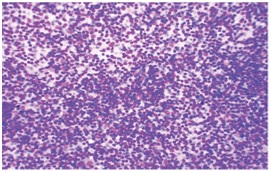Study of lymphnode lesions by fine needle aspiration cytology and histopathology: A study of 125 cases
Abstract
Background: Fine needle aspiration cytology (FNAC) is a simple and rapid diagnostic technique and because of early availability of results, simplicity, minimal trauma and complication, the aspiration cytology is now considered as a valuable diagnostic aid and is gaining popularity. It also helps in giving proper direction for appropriate investigations.
Objectives: To find out number of cases where FNAC of the lymph nodes picked up an unsuspected malignancy and to correlate the cytological findings with the histopathological findings in cases where lymph node biopsy is done.
Methodology: It was a prospective study done on patient who presented with lymphadenopathy to various departments and referred to pathology department. The aspirate was collected from the enlarged lymphnodes using standard procedure with proper aseptic condition. The aspirate was examined for the amount and nature of the aspirated material, and then several smears were prepared. Smears were immediately fixed in 95% ethyl alcohol, and these smears were examined using various stains like haematoxylin and eosin stain, PAS stain also MGG’s stain and Ziehl Neelsen stain.
Observations: out of total 125 patients, 91 (73.60%) were Male patients and 34 (26.40%) were Female patients with M:F ratio of 2.79:1 with Male predominance. Distributions of all lymph node lesions shows cervical site i.e. 97 (77.6%) followed by inguinal i.e. 14 (11.2%) and other sites. Among all lymphnode lesions, 66.40% were neoplastic lesions and 33.60% were non- neoplastic lesions. Neoplastic lesions were more common in cervical group and Metastatic squamous cell carcinoma was more common in cervical group. Cytological diagnosis was correlated with histopathology diagnosis in 13.6% cases.
Conclusion: FNAC can help not only to differentiate among lymphoma, and metastasis, but also to identify nonspecific reactive lymphadenitis and specific infections such as tuberculosis lymphadenitis. The results are quite encouraging and even more advanced diagnostic tools available, FNAC can still recommended as the initial diagnostic test in the evaluation of superficial lymphadenopathy.
Downloads
References
2. Delves PJ, Roitt IM. The immune system. First of two parts. N Engl J Med. 2000 Jul 6;343(1):37-49.DOI:10.1056/NEJM200007063430107.[pubmed]
3. Stein H, Bonk A, Tolksdorf G, et al. Immunohistologic analysis of the organization of normal lymphoid tissue and non-Hodgkin's lymphomas. J HistochemCytochem. 1980 Aug;28(8):746-60.
4. Prasad RR, Narasimhan R, Sankaran V, et al. Fine-needle aspiration cytology in the diagnosis of superficial lymphadenopathy: an analysis of 2,418 cases. Diagn Cytopathol. 1996 Dec;15(5):382-6.[pubmed]
5. Hirachand S, Lakhey M, Akhter J, et Evaluation of fine needle aspiration cytology of lymph nodes in Kathmandu Medical College, Teaching hospital. Kathmandu Univ Med J (KUMJ). 2009 Apr-Jun;7(26):139-42.[pubmed]
6. Vimal S, Dharwadkar A, Chandanwale SS, Vishwanathan V, Kumar H. Cytomorphological study of lymph node lesions: A study of 187 cases. Med J DY Patil Univ 2016;9:43-50.
7. Hafez NH, Tahoun NS. Reliability of fine needle aspiration cytology (FNAC) as a diagnostic tool in cases of cervical lymphadenopathy. J Egypt Natl Canc Inst. 2011 Sep;23(3):105-14. doi: 10.1016/j.jnci.2011.09.009. Epub 2011 Oct 24.[pubmed]
8. Steel BL, Schwartz MR, Ramzy I. Fine needle aspiration biopsy in the diagnosis of lymphadenopathy in 1,103 patients. Role, limitations and analysis of diagnostic pitfalls. Acta Cytol. 1995 Jan-Feb;39(1):76-81.[pubmed]
9. Mohanty R, Wilkinson A. Utility of fine needle aspiration cytology of lymph nodes. IOSR Journal of Dental and Medical Sciences. 2013;8:13-8.
10. Khajuria R, Goswami KC, Singh K, Dubey VK. Pattern of lymphadenopathy on fine needle aspiration cytology in Jammu. JK Sci. 2006;8:145-9.
11. Alam K, Khan A, Siddiqui F, Jain A, Haider N, Maheshwari V. Fine needle aspiration cytology (FNAC), a handy tool for metastatic lymphadenopathy. Int J Pathol. 2010;10(2).[pubmed]
12. Mehrotra R, Singh M, Gupta RK, et al. Trends of prevalence and pathological spectrum of head and neck cancers in North India. Indian J Cancer. 2005 Apr-Jun;42(2):89-93.[pubmed]
13. Rai NN, Patangia P, Meena SP. Role of fine needle aspiration cytology in diagnosis of metastatic lymphadenopathy. J. Evid. Based Med. Healthc. 2016;3:738-41.[pubmed]
14. Meena P, Mishra RT. A study of metastatic lesions of lymph nodes by fine needle aspiration cytology. Int J Res Med Sci 2017;5:4523-6.
15. Vimal S, Dharwadkar A, Chandanwale SS, Vishwanathan V, Kumar H. Cytomorphological study of lymph node lesions: A study of 187 cases. Med J DY Patil Univ 2016;9:43-50.



 OAI - Open Archives Initiative
OAI - Open Archives Initiative


